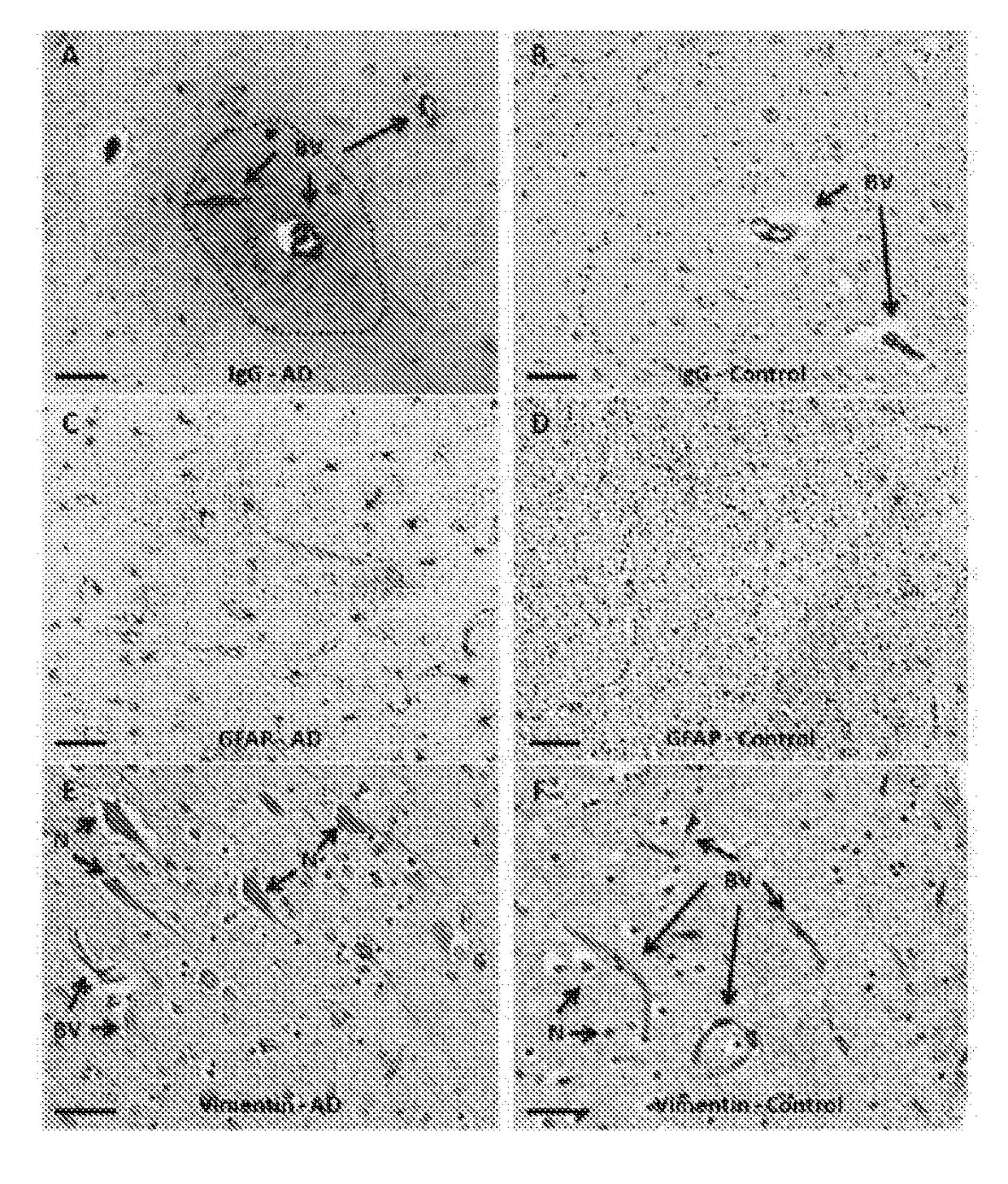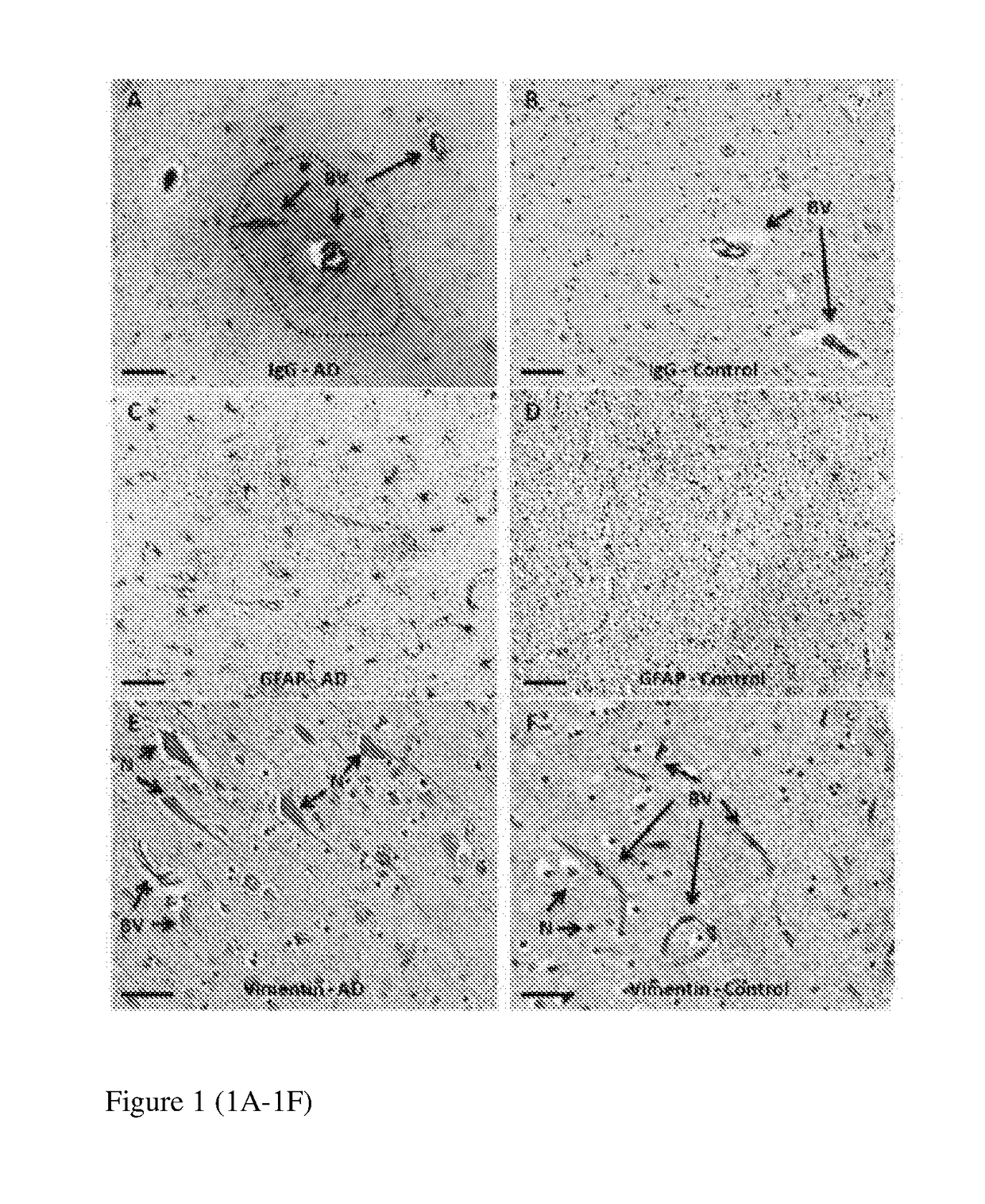Novel slice cultures and methods for diagnosing neuronal degeneration diseases
a neuronal degeneration and slice culture technology, applied in the field of slice cultures, can solve the problems of impaired neuronal function, neuronal damage and loss, and inability to allow free exchange of solutes, and achieve the effect of reducing the activity of ad biomarkers
- Summary
- Abstract
- Description
- Claims
- Application Information
AI Technical Summary
Benefits of technology
Problems solved by technology
Method used
Image
Examples
example 1
Experimental Procedures
Antibodies
[0084]Human IgG antibodies (polyclonal, Cat. No. BA-3000, dilution=1:2000) and mouse IgG antibodies (polyclonal, Cat. No. BA-9200, dilution=1:2000) were obtained from Vectastain (Foster City, Calif.). GFAP antibodies were obtained from Millipore (Billerica, Mass.) (polyclonal, Cat. No. AB5804, dilution=1:1000). Vimentin antibodies were obtained from Sigma (Saint Louis, Mo.) (monoclonal, Cat. No. V6630, dilution=1:200). The specificity of each of these antibodies was confirmed via western blot or ELISA (data not shown).
Animals
[0085]C57BL / 6J mice were obtained from Jackson Laboratories (Bar Harbor, Me.) and used at 9 months of age. Mice were maintained on ad libitum food and water with 12-hour light / dark cycle in an AAALAC-accredited vivarium under a UMDNJ IACUC-approved protocol.
Primary Mouse Brain Organotypic Cultures
[0086]Primary mouse brain organotypic cultures were prepared as described previously ((Levin et al., Brain Res. 1298, 194-207, 2009). B...
example 2
[0106]Retinal slice cultures treated with histamine also display pathologies consistent with AD. As shown in FIG. 7-9, retina with BRB breakdown and expression of GFAP and MAP2 have been observed after treatment of retinal slice cultures with histamine.
[0107]As shown in FIG. 7, retina with BRB breakdown and extravasated IgG surrounding blood vessels (indicated by dotted circles) are observed after histamine treatment (Panel: Hist). In untreated retinal slices, IgG is confined to BV lumen (Panel: Ctrl).
[0108]Histamine treatment also increases the expression of GFAP in retinal slices. FIG. 8 illustrates retinal slice cultures after treated for indicated time with histamine (0, 30, 60 or 90 min). The slices were then processed to generate cryosections for immunostaining. The expression of GFAP was monitored by immunostaining. GFAP is observed in green. The results are presented in two rows: the top one without the nuclei and the bottom one—with the nuclei in blue. A structural response...
example 3
[0110]The slice cultures of the present invention can also be used for evaluating or identifying compounds with therapeutic potential for treating or preventing neuronal degeneration diseases such as AD. As shown in FIG. 10, retinal slices were treated with histamine with or without lipoxin A4. Untreated samples served as control. The slices were then processed to generate cryosections for immunostaining. The location of IgG (an indicator of BRB breach) was monitored by immunostaining. IgG was observed in red. The results were presented in two rows: the top one without LXA4 and the bottom one—with LXA4 treatment. In the absence of LXA4, neurons were loaded with IgG and appeared in red (indicated by arrowheads) after histamine treatment. Addition of LXA4, however, conferred protection from these effects.
PUM
| Property | Measurement | Unit |
|---|---|---|
| time | aaaaa | aaaaa |
| time | aaaaa | aaaaa |
| time | aaaaa | aaaaa |
Abstract
Description
Claims
Application Information
 Login to View More
Login to View More - R&D
- Intellectual Property
- Life Sciences
- Materials
- Tech Scout
- Unparalleled Data Quality
- Higher Quality Content
- 60% Fewer Hallucinations
Browse by: Latest US Patents, China's latest patents, Technical Efficacy Thesaurus, Application Domain, Technology Topic, Popular Technical Reports.
© 2025 PatSnap. All rights reserved.Legal|Privacy policy|Modern Slavery Act Transparency Statement|Sitemap|About US| Contact US: help@patsnap.com



